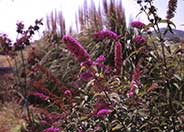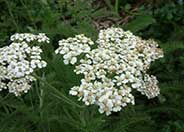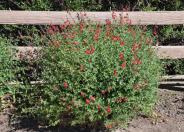
Common name:Coast Sunflower, Coast Encelia
Botanical name:Encelia californica
Encelia californica is a fast growing woody subshrub with bright green foliage and yellow daisy-type flowers. It can be used effectively in the natural landscape with regular pruning to maintain form. It is more commonly used in native restoration work. In inland situations, it requires more regular water. It grows to 3'-5' tall and 3'-5' wide.

Common name:Butterfly Bush
Botanical name:Buddleja davidii
Butterfly bush is a fast growing deciduous or semi-evergreen shrub ranging from 3' up to 10', with an open, rangy growth habit. It should be cut back nearly to the ground in fall or spring for size control and appearance. - Cornflower Farms

Common name:Yarrow
Botanical name:Achillea millefolium
This Achillea features spreading mats of fern-like rosettes, along with deeply divided leaves of a green or gray green color. In this form, the flowers are usually a white tone. Stems can reach 2'-3' above foliage. Yarrows propagate easily from rooted cuttings or division, which should be performed in the early spring or fall. Following bloom, one should dead head the plant and divide the clumps when it appears crowded.

Common name:Autumn Sage
Botanical name:Salvia greggii
The autumn sage is a hybrid evergreen shrub that grows 3-4 ft. high It has fragrant green leaves and colorful flowers that bloom in spring and summer. This evergreen shrub can tolerate sun or partial shade and is hardy to 15 degrees F. The autumn sage is drought tolerant and attracks hummingbirds. The flower colors that can be grown are: Coral, Pink, Purple, Red, and White.
-Cornflower Farms
Dealing With Drought
More than half of the water used at your home is for outside purposes. Studies show that on average, half of the water used outdoors is wasted. The leading cause of waste is incorrectly set and poorly managed irrigation controllers. The second biggest cause of wastage is broken irrigation equipment that goes undetected. There are a few basic things you can do to make a big difference in your water use.
Click in the green box for more information
| Designer: RCRCD | Riverside Conservation Journey 3 |
Photographer: GardenSoft |
Soils and Compost:
Maintain a two to four inch layer of mulch on the soil surface to reduce weeds, infiltrate rain water, and reduce compaction.
Water Saving Tip:
Integrated Pest Management:
Remove irrigation water and fertilizer from areas where you don't want weeds to grow.

